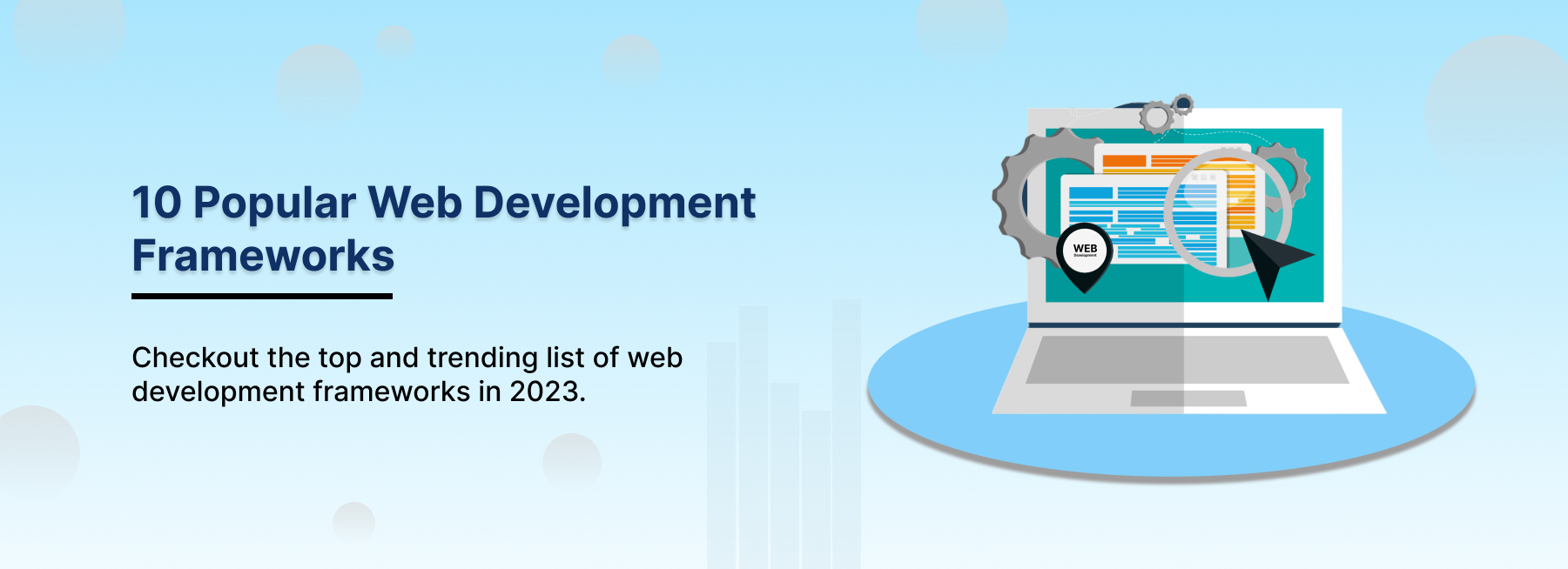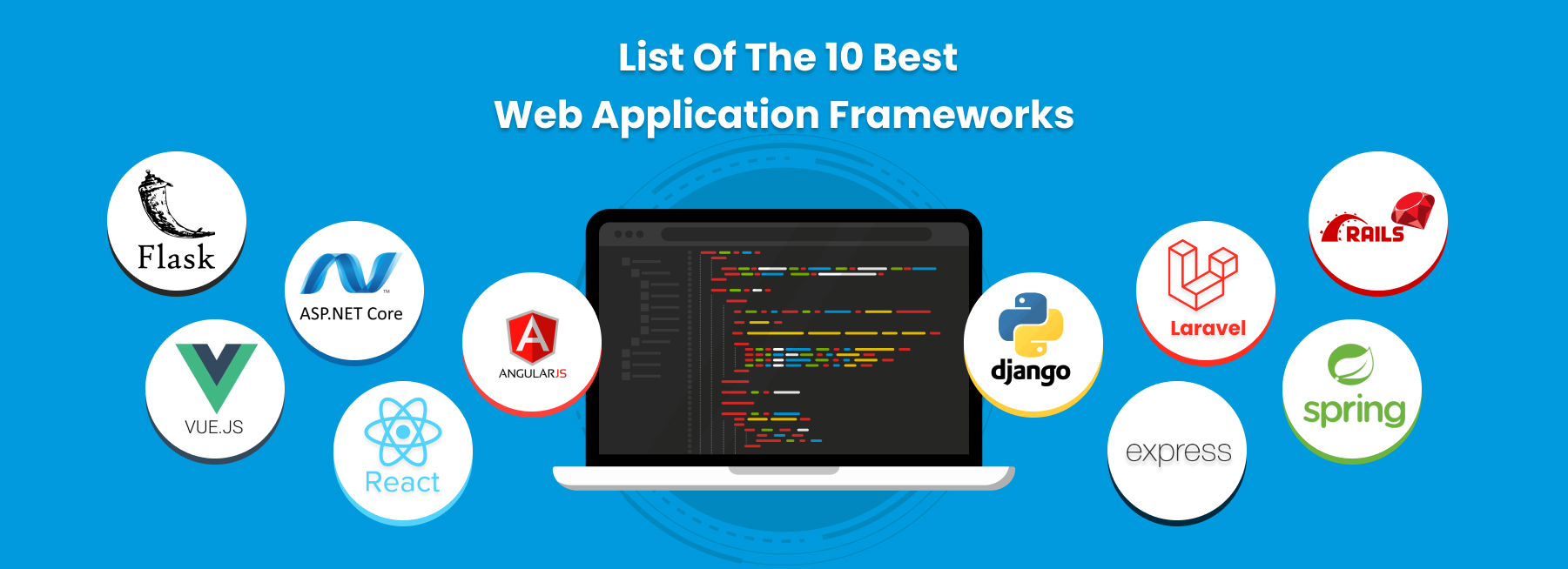 18 Oct 2023
18 Oct 2023
A pre-arranged collection of tools and best practices is known as a web development framework. These are the foundations of the web development sector. They facilitate the development of strong, highly effective websites. Let's embark on a journey to explore the significance of these frameworks and witness their transformative power.
Understanding the Types of Web Development Frameworks
Web development frameworks can be divided into frontend and backend categories. The user interface is the focus of frontend frameworks. On the other side, backend frameworks, handle server-side coding.
- Frontend Frameworks: These are responsible for the visual aspects of a web application. They define how the application looks and feels.
- Backend Frameworks: The logic of the application, database transactions, user authentication, and other tasks are all managed by backend frameworks.
Useful Features of Web Development Platforms
Frameworks are utilised in the current web development industry to improve the efficiency and usefulness of websites. With its tools and guides, it aids developers as well. Here are a few primary reasons for why web developers choose to employ frameworks:
- Faster Development Process: The development cycle is sped up with a suitable foundation. Developers may get a head start with pre-written code rather than beginning from scratch.
- Structured Codebase: Frameworks bring order to chaos. They ensure organized and maintainable code, making it easier for teams to collaborate.
- Enhanced Security Features: Safety first! Frameworks often come with built-in security measures, offering a sturdy shield against common web threats.
- Built-in Tools: Why reinvent the wheel? Frameworks offer essential tools and extensions, streamlining the development process.
- Active Community: There's strength in numbers. A thriving community means extensive documentation, regular updates, and peer support.
Architectural Patterns in Web Development Platforms
Patterns form the blueprint of our projects. Some prevalent patterns include:
- MVC (Model-View-Controller): A triad that segregates database, user interface, and business logic.
- MVVM (Model-View-ViewModel): Enhances MVC by introducing a ViewModel, aiding data presentation.
- SPA (Single Page Applications): Offers a seamless user experience by reloading parts of a page, not the entire page.
- Micro-services Architecture: Breaks applications into smaller, manageable pieces that function independently.
There are several web development frameworks on the market today. You can choose the one for your development-related task depending on your requirements. Here is a list of the 10 best web application framework used in this industry in 2023.
Read More - Custom Web Application Development Services
List of The 10 Best Web Application Frameworks

Angular
Hailing from Google's lab, Angular has steadily climbed the popularity ladder. With its SPA and MVVM patterns, it offers a seamless user journey.
Angular, initially released in 2010, has undergone multiple transformations. Today, it stands as a robust platform for building dynamic web apps.
Key Features:
- Two-way data binding streamlines real-time updates.
- Dependency injection boosts efficiency and modularity.
- Directives offer extended HTML capabilities.
Typical use cases: Perfect for SPAs, enterprise-grade apps, and dynamic web applications.
React
Facebook's brainchild, React, has revolutionized user interfaces. Its component-based architecture ensures reusable and maintainable code.
Since its debut in 2013, React has won hearts. It's a library that excels at creating user interfaces, not simply a framework.
Key Features:
- Virtual DOM ensures efficient updates.
- JSX blends JavaScript with HTML, offering a concise syntax.
- Unidirectional data flow enhances predictability and debugging.
Typical use cases: Ideal for single-page applications, mobile applications (using React Native), and interactive user interfaces.
Django
Django, fondly known as the "web framework for perfectionists," holds a special place in the developer's toolkit.
Born in 2005, Django has matured like fine wine. It prioritizes swift development without compromising on clean design.
At its heart, Django follows the MVT (Model-View-Template) design. This pattern closely mirrors MVC but with a twist. The Template plays the role of the View, guiding the presentation layer.
Key Features:
- Built-in admin interface simplifies content management.
- ORM (Object Relational Mapping) aids in database operations, bridging the gap between data models and databases.
- Middleware support ensures a plug-and-play experience.
Typical use cases: Suitable for content-heavy sites, e-commerce platforms, and applications demanding rapid development.
Ruby on Rails
Often called "Rails," this framework stands tall with its convention over configuration (CoC) principle.
Since 2005, Rails has empowered developers by providing a predefined set of best practices and defaults.
Rails embodies the MVC architecture. It believes in keeping things DRY (Don't Repeat Yourself), and promoting code reusability.
Key Features:
- Seamless database table creation through migrations.
- Rich libraries and plugins extend functionality.
- Built-in testing tools reinforce robust development.
Typical use cases: From startups to established giants, Rails fits the bill for web applications, especially when development speed is crucial.
Vue.js
For the best of both worlds, Vue.js combines efficiency and reliability.
Vue.js was first launched in 2013 by an ex-Google developer, and since then, it has been rapidly gaining popularity. Considering that its primary library focuses on the display layer, it is easy to use and integrate.
Key Features:
- Reactive data binding ensures a responsive experience.
- Component-based architecture offers modular solutions.
- An easy learning curve, especially for those familiar with HTML and JS.
Typical use cases: Perfect for modern web interfaces, SPAs, and complex web applications when paired with modern tooling.
Flask
Flask offers simplicity without being simplistic. It's a micro web framework that packs a punch.
Born in 2010 as an April Fool's prank, Flask has since become a force to reckon with. It stands out for its minimalistic approach.
Flask is all about freedom. It doesn't prescribe any specific architectural pattern, allowing developers to sculpt their desired structure.
Key Features:
- Jinja2 templating brings dynamic web pages to life.
- Lightweight and modular design caters to both small and large applications.
- Extensions enhance its capabilities, moulding Flask to varied needs.
Typical use cases: Flask shines in single-page applications, APIs, and projects where flexibility is paramount.
ASP.NET Core
For those invested in the Microsoft ecosystem, ASP.NET Core is the knight in shining armour.
Evolving from the classic ASP.NET, this open-source framework supports cross-platform development, making it a versatile choice.
It champions both MVC and MVVM designs. The razor view engine gracefully handles the view component.
Key Features:
- Cross-platform capabilities mean applications run on Windows, Linux, and macOS.
- Inbuilt dependency injection simplifies code management.
- Performance optimizations ensure lightning-fast applications.
Typical use cases: Web APIs, real-time applications, enterprise-grade solutions, and cross-platform needs align perfectly with ASP.NET Core.
Express.js
Express.js, a minimalist framework for Node.js, is the unsung hero of backend development.
A part of the famed MEAN stack, Express came to life in 2010. It aims to provide essential web server features without overshadowing Node's features.
Express thrives on middleware. These functions have access to request and response objects, executing sequentially and deciding the flow.
Key Features:
- Routing mechanisms define server endpoints efficiently.
- Middleware stack handles tasks like logging, request parsing, and content compression.
- Seamless integration with other Node.js modules.
Typical use cases: Suited for single-page apps, websites, hybrids, and public HTTP APIs.
Spring Boot
Spring Boot simplifies the process of building production-ready applications.
An offspring of the larger Spring framework, Spring Boot arrived in 2014. It eliminates boilerplate code, paving the way for a smoother Java experience.
Spring Boot, with its MVC focus, is tailored for enterprise applications. It integrates effortlessly with the Spring ecosystem.
Key Features:
- Auto-configuration detects and configures beans, minimizing manual labour.
- Standalone nature eliminates server dependency.
- An array of production-ready tools streamlines monitoring and troubleshooting.
Typical use cases: Spring Boot allows for the coexistence of micro-services, web and RESTful apps, data-driven systems, and giant corporate applications.
Laravel
Laravel is more than simply a framework; it's a lifeline for many PHP developers.
Laravel made its debut in 2011, rising swiftly in the ranks of PHP frameworks. Its clean syntax and expressive style have won accolades, making it a favourite among modern web artisans.
Laravel takes a firm stand with the MVC design. This separation ensures clarity between business logic, user interface, and underlying data structures.
Key Features:
- Eloquent ORM provides an elegant way to interact with databases, making CRUD operations a breeze.
- Blade templating engine seamlessly combines data and views, rendering dynamic content effortlessly.
- Artisan, Laravel's command-line tool, automates many repetitive tasks, speeding up the development cycle.
Typical use cases: Laravel is a versatile player. Be it e-commerce platforms, RESTful APIs, small web apps, or extensive enterprise solutions, Laravel adapts and delivers.
In the rapidly developing sector of web development, picking the finest web development platforms might make all the difference. Understanding the advantages of each will help developers make wise judgements that will result in applications that are reliable, scalable, and effective.